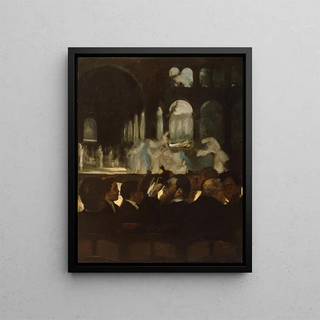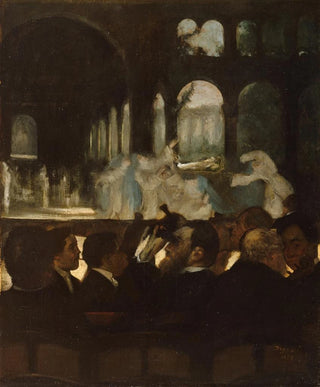Art print | The Ballet of Robert le Diable - Edgar Degas


View from behind

Frame (optional)
In the fascinating world of art, some works transcend their era to become symbols of timeless creativity. "The Ballet of Robert le Diable" by Edgar Degas is one of those creations that capture the very essence of dance and Parisian life in the 19th century. This piece, inspired by an opera by Giacomo Meyerbeer, evokes a vibrant and dynamic atmosphere, where the movement and grace of the dancers are beautifully rendered. The art print of this iconic work allows appreciation of Degas's virtuosity, while offering a window into the history of ballet, an art form that has profoundly influenced French culture.
Style and uniqueness of the work
Edgar Degas's style is often characterized by an innovative approach to composition and light. In "The Ballet of Robert le Diable," he manages to capture not only the movement of the dancers but also the emotional intensity of the performance. The vibrant colors and bold brushstrokes testify to his skill in playing with shadows and lights. The scene depicts figures in full action, creating a sense of dynamism that immediately draws the viewer's eye. Degas also employs unusual angles, providing a unique perspective that immerses the audience in the very experience of ballet. This stylistic choice, combined with meticulous attention to costume details and expressions, makes this work a perfect example of Impressionism, while standing out through its narrative character.
The artist and his influence
Edgar Degas, often regarded as one of the masters of Impressionism, knew how to blend tradition and modernity in his work. Born in Paris in 1834, he was deeply influenced by the city's cultural life, notably by the world of ballet. His interactions with dancers and his careful observation of their movements allowed him to create works that go beyond simple representation. Degas also explored themes such as solitude and intimacy, which give his paintings a rare emotional depth. His influence extends well beyond his own era, inspiring generations of artists to explore the

Matte finish

View from behind

Frame (optional)
In the fascinating world of art, some works transcend their era to become symbols of timeless creativity. "The Ballet of Robert le Diable" by Edgar Degas is one of those creations that capture the very essence of dance and Parisian life in the 19th century. This piece, inspired by an opera by Giacomo Meyerbeer, evokes a vibrant and dynamic atmosphere, where the movement and grace of the dancers are beautifully rendered. The art print of this iconic work allows appreciation of Degas's virtuosity, while offering a window into the history of ballet, an art form that has profoundly influenced French culture.
Style and uniqueness of the work
Edgar Degas's style is often characterized by an innovative approach to composition and light. In "The Ballet of Robert le Diable," he manages to capture not only the movement of the dancers but also the emotional intensity of the performance. The vibrant colors and bold brushstrokes testify to his skill in playing with shadows and lights. The scene depicts figures in full action, creating a sense of dynamism that immediately draws the viewer's eye. Degas also employs unusual angles, providing a unique perspective that immerses the audience in the very experience of ballet. This stylistic choice, combined with meticulous attention to costume details and expressions, makes this work a perfect example of Impressionism, while standing out through its narrative character.
The artist and his influence
Edgar Degas, often regarded as one of the masters of Impressionism, knew how to blend tradition and modernity in his work. Born in Paris in 1834, he was deeply influenced by the city's cultural life, notably by the world of ballet. His interactions with dancers and his careful observation of their movements allowed him to create works that go beyond simple representation. Degas also explored themes such as solitude and intimacy, which give his paintings a rare emotional depth. His influence extends well beyond his own era, inspiring generations of artists to explore the






